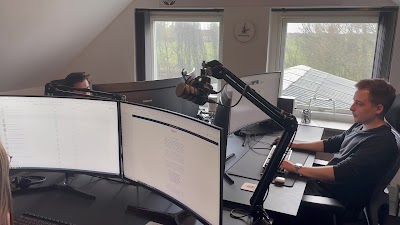Print on demand (POD) is often marketed as the ultimate “free to start” business model. However, is this really the case? While POD eliminates the need for upfront inventory investment, the reality is quite different from the marketing promises. According to industry data, the average POD seller spends between $200–$500 to properly launch their business. This article breaks down the actual print on demand costs you’ll encounter, helping you create a realistic budget and avoid financial surprises along the way.
Understanding these costs upfront is crucial for your success. Many aspiring entrepreneurs dive into POD expecting zero expenses, only to discover hidden fees and necessary investments that can quickly drain their resources. By the end of this comprehensive guide, you’ll have a clear picture of what it really takes to launch and maintain a profitable print on demand business.
The myth of zero-cost print on demand
POD platforms love to advertise their services as completely free to start. Shopify, Etsy, Amazon Merch on Demand, and countless other platforms emphasize that you can begin selling without any upfront investment. While technically true, this marketing message creates unrealistic expectations for new entrepreneurs.
The reality is that tools and marketing expenses add up quickly. Sure, you can create a basic store account for free, but competing effectively requires professional design software, quality product samples, marketing campaigns, and various other investments. Moreover, most successful POD sellers reinvest their early profits into scaling their operations.
Consider this analogy: opening a traditional retail store requires significant upfront capital for inventory, rent, and equipment. POD eliminates inventory costs but replaces them with different expenses like digital marketing, design tools, and platform fees. The barrier to entry is lower, but it’s not zero.
Furthermore, the “free” model often comes with limitations that force upgrades. Free design tools have watermarks, free hosting plans lack professional features, and free marketing reaches minimal audiences. Therefore, treating POD as a serious business venture requires acknowledging these inevitable costs from the beginning.
Essential fixed startup costs for print on demand
Every POD business requires certain fixed startup investments to operate professionally. These one-time or recurring expenses form the foundation of your business operations and directly impact your credibility with customers.
Domain and hosting expenses
A professional domain name costs approximately $10-15 annually, while quality hosting ranges from $5-25 monthly. Although some platforms offer free subdomains, having your own domain builds trust and brand recognition. For example, “yourstore.com” appears more professional than “yourstore.platform.com” to potential customers.
Design tools and software
Design tools represent a significant portion of print on demand costs. Canva Pro costs $12.99 monthly, Adobe Creative Suite runs $52.99 monthly, and Photoshop alone costs $20.99 monthly. Free alternatives like GIMP exist, but they require more time investment and produce less polished results. Professional designs directly correlate with higher conversion rates and customer satisfaction.
Business registration and legal requirements
Depending on your location, business registration fees range from $50-500. Additionally, you may need business insurance ($200-400 annually) and accounting software like QuickBooks ($15-25 monthly). These expenses ensure legal compliance and professional financial management.
Understanding variable print on demand costs
Variable costs fluctuate based on your business activities and growth strategies. Unlike fixed costs, these expenses scale with your operations and marketing efforts, making them harder to predict but easier to control.
Product samples and quality testing
Ordering product samples is crucial for quality control and marketing photography. Expect to spend $50-200 initially on various products to test print quality, material feel, and sizing accuracy. Many successful sellers order samples of every new design, especially when launching seasonal collections or testing new products.
Quality testing extends beyond initial samples. As you expand your product line or switch suppliers, additional sampling becomes necessary. Smart sellers budget 5-10% of their monthly revenue for ongoing quality assurance, ensuring consistent customer satisfaction.
Paid advertising campaigns
Paid advertising represents the largest variable expense for most POD businesses. Facebook Ads, Google Ads, and Pinterest Ads typically require $100-500 monthly budgets for meaningful results. However, advertising costs can scale dramatically as you identify profitable campaigns and expand your reach.
Successful POD sellers often follow the 70/30 rule: 70% of ad spend goes to proven, profitable campaigns, while 30% tests new audiences and creative approaches. This strategy balances consistent returns with growth opportunities, though it requires careful budget management and performance tracking.
Hidden expenses that impact your print on demand costs
Beyond obvious expenses lie numerous hidden costs that catch new POD entrepreneurs off guard. These seemingly small fees accumulate quickly and can significantly impact your profit margins if not properly accounted for in your pricing strategy.
Transaction and processing fees
Payment processors charge 2.9% + $0.30 per transaction on average. Additionally, POD platforms often take 3-15% commission on each sale. For example, if you sell a $25 t-shirt, you might pay $0.73 in payment processing, $3.75 in platform fees, plus $12-15 in production costs, leaving roughly $7-9 profit before advertising expenses.
Currency conversion fees add another layer for international sales. These typically range from 1-3% per transaction, further eroding profit margins. Therefore, accurate fee calculation is essential for competitive pricing while maintaining profitability.
Returns and refund management
Return rates for POD products average 10-15%, higher than traditional retail due to sizing uncertainties and print quality variations. Each return costs you the original production expense, shipping costs, and potential restocking fees. Moreover, processing returns requires time investment that could otherwise generate revenue.
Refund policies also impact cash flow. Most platforms hold funds for 7-14 days, and returns can freeze payments for additional periods. Smart sellers maintain cash reserves equal to 20-30% of monthly revenue to handle return-related cash flow disruptions.
Customer service and communication tools
Professional customer service requires investment in communication tools and time. Email marketing platforms like Mailchimp cost $10-50 monthly, customer service software ranges from $15-100 monthly, and social media management tools add another $10-50 monthly expense.
Smart strategies to minimize print on demand costs
Reducing expenses without compromising quality requires strategic thinking and gradual scaling. The key is starting lean while positioning yourself for sustainable growth as revenue increases.
Leveraging free trials and freemium options
Most professional tools offer free trials or freemium versions. Canva provides substantial free functionality, GIMP offers professional design capabilities at no cost, and many email marketing platforms include free tiers for small subscriber lists. Start with these options while testing your business concept and market demand.
However, plan upgrade timelines carefully. Free tools often have limitations that become problematic as you scale. For instance, free email marketing typically limits subscriber counts, and free design tools may lack advanced features necessary for competitive designs.
Gradual reinvestment strategies
Instead of investing heavily upfront, successful POD sellers reinvest profits gradually. Start with a $200-300 budget covering essential tools and initial samples. As revenue grows, allocate 30-50% of profits back into the business for upgraded tools, expanded advertising, and improved operations.
This approach reduces financial risk while ensuring steady growth. For example, month one might focus on design tools and samples, month two could add email marketing capabilities, and month three might introduce paid advertising campaigns. Each investment builds upon previous successes rather than gambling on unproven concepts.
Bulk purchasing and partnership opportunities
As your business grows, explore bulk purchasing options for frequently used services. Annual subscriptions often provide 15-20% discounts compared to monthly payments. Additionally, some POD platforms offer reduced fees for high-volume sellers or exclusive partnership opportunities.
Platform-specific print on demand costs comparison
Different POD platforms have varying fee structures and requirements that significantly impact your overall costs. Understanding these differences helps you choose the most cost-effective platform for your specific business model and target market.
Shopify and e-commerce platforms
Shopify charges $29 monthly for basic plans, plus 2.9% + $0.30 per transaction. However, you gain complete control over customer relationships, branding, and pricing strategies. Additional apps for email marketing, reviews, and analytics can add $50-200 monthly, but these investments often improve conversion rates and customer lifetime value.
The total cost of ownership for Shopify-based POD stores typically ranges from $100-400 monthly, depending on app usage and transaction volume. However, higher profit margins and customer retention often justify these increased expenses for serious sellers.
Marketplace platforms like Etsy and Amazon
Etsy charges $0.20 listing fees plus 6.5% transaction fees, while Amazon Merch on Demand takes 15-30% royalties depending on product type and pricing. These platforms provide built-in traffic but limit branding opportunities and customer relationship building.
Marketplace success often requires different cost structures, emphasizing listing optimization tools ($10-50 monthly) and keyword research software ($20-100 monthly) over traditional advertising and website development expenses. Total monthly costs typically range from $50-200, making marketplaces attractive for beginners with limited budgets.
Hybrid approaches and multi-platform strategies
Many successful POD sellers use hybrid approaches, starting on marketplaces to validate products and generate initial revenue, then expanding to independent stores for higher margins and better customer relationships. This strategy requires managing multiple fee structures but often maximizes overall profitability.
Seasonal fluctuations in print on demand costs
POD businesses experience significant seasonal variations in both costs and revenue. Understanding these patterns helps with budget planning and cash flow management throughout the year.
Holiday season advertising competition
Advertising costs typically increase 25-50% during Q4 due to increased competition for consumer attention. Facebook and Google Ads become more expensive as retailers compete for holiday shoppers. Therefore, successful POD sellers either increase advertising budgets proportionally or focus on organic marketing strategies during peak seasons.
However, higher advertising costs often coincide with increased consumer spending and higher conversion rates. Many POD sellers generate 40-60% of annual revenue during Q4, justifying the increased marketing investment despite higher costs per acquisition.
Production and shipping delays
Peak seasons also bring production delays and increased shipping costs. POD providers often extend production times from 2-3 days to 7-10 days during busy periods. Additionally, expedited shipping options become more expensive, and some providers implement temporary surcharges.
Smart sellers plan for these fluctuations by adjusting product launch timelines, setting customer expectations appropriately, and potentially raising prices to offset increased costs while maintaining profit margins.
Inventory planning for hybrid models
Some POD sellers transition to hybrid models during peak seasons, ordering inventory in advance to ensure faster shipping and better margins. This requires additional upfront investment but can significantly improve customer satisfaction and reduce per-unit costs during high-volume periods.
Long-term financial planning for print on demand businesses
Sustainable POD businesses require comprehensive financial planning that extends beyond initial startup costs. Understanding long-term financial patterns helps build profitable, scalable operations.
Scaling costs and revenue projections
As POD businesses grow, costs typically scale at different rates than revenue. Fixed costs like software subscriptions remain relatively stable, while variable costs like advertising and samples increase proportionally with sales volume. However, economies of scale often improve profit margins over time.
Successful POD sellers typically see break-even points around months 3-6, followed by steady profit growth as they optimize advertising campaigns, improve conversion rates, and expand product lines. Financial projections should account for this growth curve while maintaining realistic expectations about timeline and investment requirements.
Tax implications and business structure
POD businesses have specific tax considerations that impact overall profitability. Business expenses like design software, samples, and advertising are typically deductible, but proper record-keeping is essential. Additionally, sales tax requirements vary by location and sales volume, potentially requiring additional compliance investments.
Consider consulting with accountants familiar with e-commerce businesses to optimize tax strategies and ensure compliance. Professional accounting services cost $100-500 monthly but often save more through proper deduction strategies and compliance management.
Exit strategies and business valuation
Even early-stage POD businesses benefit from considering long-term exit strategies. Businesses with diversified revenue streams, strong customer relationships, and documented processes typically command higher valuations than those dependent on single platforms or products.
Building valuable business assets requires additional investments in systems, documentation, and team development, but these expenses often pay dividends through improved operations and potential sale value.
Creating your print on demand budget template
Developing a comprehensive budget template helps track expenses, plan investments, and maintain profitability throughout your POD journey. A well-structured budget should account for all cost categories while providing flexibility for growth and unexpected expenses.
Essential budget categories
Your POD budget should include the following categories: fixed monthly expenses (software, hosting, subscriptions), variable costs (advertising, samples, fees), one-time investments (equipment, initial setup), and contingency funds (returns, unexpected expenses). Allocate percentages based on your business model and growth stage.
For example, new businesses might allocate 40% to advertising, 20% to tools and software, 15% to samples and testing, 15% to fees and processing, and 10% to contingencies. Established businesses often shift toward higher advertising percentages while reducing tool and setup expenses.
Monthly budget tracking and adjustment
Regular budget review and adjustment ensures financial health and identifies optimization opportunities. Track actual expenses against budgeted amounts monthly, identifying variances and their causes. This process helps refine future budgets while highlighting areas for cost reduction or increased investment.
Use tools like Google Sheets, Excel, or dedicated accounting software to maintain accurate records. Many successful POD sellers spend 2-3 hours monthly on financial review and planning, considering this time investment essential for long-term success.
ROI calculation and performance metrics
Understanding return on investment for each expense category helps optimize budget allocation. Calculate ROI for advertising campaigns, design tool investments, and platform fees separately. This granular analysis reveals which investments drive the highest returns and deserve increased allocation.
Key metrics include cost per acquisition, customer lifetime value, profit margins by product category, and return on ad spend. Regular monitoring of these metrics ensures budget decisions support overall business objectives rather than just minimizing expenses.
Understanding print on demand costs is crucial for building a sustainable and profitable business. While POD platforms market themselves as free to start, the reality involves numerous expenses that can quickly add up without proper planning. From essential design tools and advertising campaigns to hidden fees and seasonal fluctuations, successful POD entrepreneurs must budget for various cost categories.
The key takeaway is that POD is low-cost, not no-cost. Average startup investments of $200-500 represent a fraction of traditional retail requirements, but they’re still necessary for competitive operations. Smart financial planning, gradual scaling, and careful expense tracking separate successful POD businesses from those that struggle with cash flow and profitability.
Remember that these investments in your POD business often pay dividends through improved conversion rates, better customer satisfaction, and higher profit margins. The sellers who treat POD as a serious business venture and budget accordingly typically achieve better long-term results than those who attempt to operate with zero investment.
Before starting your print on demand journey, create a comprehensive budget that accounts for all the costs discussed in this guide. Start conservatively, track your expenses carefully, and reinvest profits strategically as your business grows. With proper financial planning, your POD business can achieve sustainable profitability while minimizing financial risk.








